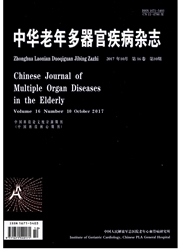

 中文摘要:
中文摘要:
目的 骨桥蛋白(OPN)在动脉易损斑块中高表达,本研究通过构建偶联骨桥蛋白(OPN)抗体的聚乳酸(PLA)纳米颗粒,实现OPN的超声纳米分子成像.方法 通过乳化溶剂挥发法制备包裹液态氟碳的PLA纳米颗粒,经碳二亚胺法进行聚乙二醇(PEG)亲水性修饰和OPN抗体偶联,得到OPN靶向的超声成像纳米探针.对探针进行表征,CCK-8法检测探针毒性,激光共聚焦显微镜评估细胞摄取,超声诊断仪进行体外超声成像.结果 PLA纳米颗粒呈球形或类球形,水合粒径为(267.60±82.40)nm;CCK-8毒性实验显示,经不同浓度探针(0.00~0.50 mg/ml)的孵育后,各实验组与空白对照组比较细胞活性差异无统计学意义(P〉0.05);靶向OPN的纳米颗粒在泡沫细胞内摄取明显增多(P〈0.05);乳胶管超声成像见纳米探针在反向脉冲谐波成像(PIHI)模式下显示为点状密集高回声影像.结论 本实验构建的靶向OPN纳米探针生物相容性好,能够在体外与OPN高表达的泡沫细胞模型特异性结合,超声成像效果良好.
 英文摘要:
英文摘要:
Objective Osteopontin (OPN) is highly expressed in vulnerable atherosclerotic plaques and suggested to be a good bio-marker and imaging target.This study was aimed at designing poly lactic acid (PLA) nanoparticles coupled with OPN antibodies for OPN-targeted ultrasonic molecular imaging.Methods PLA-perfluorooctyl bromide nanoparticles (PLA-PFOB NPs) were prepared by oil-in-water emulsion process.Subsequently, amino polyethylene glycol carboxyl (NH2-PEG-COOH) was attached to PLA through carbodiimide method.OPN antibody was conjugated with PEG-PLA-PFOB NPs by amide bonds to obtain OPN-targeted nanoprobe for ultrasound imaging.The biocompatibility of PLA NPs was evaluated in RAW264.7 cells by CCK-8 assay.Morphological characterizations of the probes were detected by transmission electron microscopy and particle size analyzer.Sensibility of the probes was evaluated by cellular uptake assay under laser scanning confocal microscope.Ultrasonic imaging was conducted with enhanced ultrasonography with PLA NPs as contrast agent.Results The PLA NPs were sphere or spherical in shape, with a hydrodynamic size of (267.60±82.40)nm.CCK-8 assay revealed that the nanoprobes showed negligible cytotoxicity at a dose from 0.00 to 0.50 mg/ml in foam cells, and no significant difference was observed in cell viability in different groups of cells (P〉0.05).Cellular uptake assay also showed there were obviously large amount of the nanoparticle in the foam cells (P〈0.05).Ultrasound imaging showed the probes presented fine punctuate hyper echo with no attenuation for the rear echo in the latex tubes on the pulse inversion harmonic image.Conclusion Our prepared OPN-targeted ultrasound contrast nanoprobes are of high biocompatibility, and can specifically bind to OPN highly expressed foam cells, and have excellent ultrasound signals in contrast-enhanced ultrasound imaging.
 同期刊论文项目
同期刊论文项目
 同项目期刊论文
同项目期刊论文
 期刊信息
期刊信息
